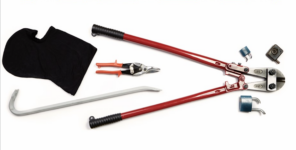The Offence of Being Armed with Intent to Commit an Indictable Offence in NSW

A passenger has been charged with a string of criminal offences after allegedly shooting two drivers with a nail gun in separate incidents on the New South Wales Central Coast.
According to police, they responded to reports at around 4.10pm on Monday, 9 January 2023 of two men being shot with a nail gun by a passenger in another vehicle while driving northbound on the M1 Motorway between Somersby and Ourimbah.
One of the drivers, a 57-year old man, allegedly told police he was driving his Mitsubishi sedan with the window down near Somersby when struck in his right arm with a nail as a white Mitsubishi truck passed his vehicle.
Shortly thereafter, a 52-year old man reported feeling an impact to the top of his head which caused him to briefly lose control of the Toyota RAV 4 he was driving near Ourimbah. The driver said he looked out of his vehicle and saw a male passenger leaning out of a white Mitsubishi truck firing projectiles towards his vehicle, causing the passenger side window to shatter.
Police say that at around 4.30pm the same afternoon, they attended a commuter car park on Sparks Road and located what they suspected to be the Mitsubishi truck in question.
They allege that while speaking to the occupants, a 19-year old male exited the vehicle and ran across the road before climbing over a wire fence.
Police say they caught up with the young man and used pepper spray to subdue him, before formally placing him under arrest, conveying him to Wyong police station and charging him with:
- Being armed with intent to commit a serious indictable offence,
- Two counts of assault occasioning actual bodily harm in company, and
- Intentional or reckless damage.
Police say the man had an outstanding warrant for his arrest.
Details of the actual bodily harm occasioned to the complainants has not been released.
The defendant will appear in Wyong Local Court to face the allegations against him.
The offence of armed with intent in New South Wales
Being armed with intent to commit an indictable offence is a crime under section 114 of the Crimes Act 1900 (NSW) which carries a maximum penalty of 7 years in prison.
The section contains the following four subsections:
Being armed with intent
Section 114(1)(a) is the general offence of being armed with intent to commit a serious indictable offence.
To establish the offence, the prosecution must prove beyond reasonable doubt that:
- You were armed with a weapon or instrument, and
- You had the item with the intention of committing an indictable offence.
What is being armed?
The Act makes clear that being ‘armed’ includes bearing or having the immediate physical possession the weapon or instrument.
What is a weapon or instrument?
The term ‘weapon or instrument’ is broadly defined for the purposes of the offence to encompass dangerous weapons, offensive weapons or instruments and any other items capable for being used for committing an indictable offence.
A dangerous weapon is defined as:
- A firearm, or an imitation firearm within the meaning of the Firearms Act 1996,
- A prohibited weapon within the meaning of the Weapons Prohibition Act 1998, or
- A spear gun.
Schedule 1 of the Weapons Prohibition Act contains a long list of prohibited weapons.
An offensive weapon or instrument is defined as:
- A dangerous weapon,
- Any thing that is made or adapted for offensive purposes, or
- Any thing that, in the circumstances, is used, intended for use or threatened to be used for offensive purposes, whether or not it is ordinarily used for offensive purposes or is capable of causing harm.
The last bullet point is a ‘catch all’ which extends to virtually anything that may be used to assist in the commission of an indictable offence.
What is an indictable offence?
‘Indictable offences’ are those which can be ‘committed’ (referred) to a higher court such as the District or Supreme Court.
These are more serious than ‘summary offences’, which if charged by themselves are finalised in the Local Court.
Indictable offences generally carry maximum penalties of more than 2 years in prison, which applies to most offences contained in the Crimes Act 1900 such as most offences against persons such as assaults and robberies, as well as offences against property such as break and enters, larcenies and other stealing offences.
As the District Court has noted, ‘An indictable offence can be anything from murder to common assault’: R v McDowell [2019] NSWDC 441 at 10.
What is intent?
Whether or not the prosecution is able to prove a person had the required intent to commit an indictable offence is a matter for the fact finder, such as the magistrate in a Local Court hearing or jury in a District Court trial.
Evidence of intent may be inferred from any of several circumstances, such as the weapon or instrument being concealed; R v Milligan [2019] NSWDC 562 at 39, a person signalling an intention to cause immediate physical harm to another person while holding the item; Sahartor v R [2018] NSWCCA 236 at 14, the utility or involvement of the item in the alleged intended or actual offence; R v Bonnell [2020] NSWDC 270 at 7, arming oneself with the item shortly before the intended or actual offence; R v Le [2019] NSWSC 633 at 58, and any other facts that may be relevant in making a determination regarding intent.
Possessing housebreaking / safebreaking / carbreaking implements
Section 114(1)(b) is the offence of possessing a housebreaking, safebreaking or carbreaking implement.
To establish the offence, the prosecution must prove beyond reasonable doubt that:
- You possessed an implement,
- The implement was capable of breaking into a house or safe, or being used to enter or drive a conveyance, and
- You did not have a lawful excuse for possessing the implement.
What is a conveyance?
A ‘conveyance’ is defined as any cab, carriage, motor car, caravan, trailer, motor lorry, omnibus, motor or other bicycle, or any ship, or vessel, used in or intended for navigation.
What is to ‘drive’?
In terms of the meaning of ‘drive’, the Act simply states and ‘drive shall be construed accordingly’. This would, of course, extend to any item capable of being used to ‘hotwire’ or otherwise start an engine without a key or by way of any other usual method.
What is a lawful excuse?
The term ‘lawful excuse’ is not defined by the Act. Rather, the meaning is determined by the fact finder such as the magistrate in a Local Court hearing or jury in a District Court trial.
That said, lawful excuses include where the item was used in the person’s trade, vocation, profession, or hobby or other recreational purpose.
Having face blackened or disguised with intent to commit indictable offence
Section 114(1)(c) is the offence of having face blackened or otherwise disguised with intent to commit an indictable offence.
To establish the offence, the prosecution must prove beyond reasonable doubt that:
- You had your face blackened or disguised, or possessed a means of blackening or disguising your face, and
- You did so with the intention of committing an indictable offence.
The offence extends to the wearing or possession of balaclavas and other disguises with the intention of committing crimes.
Being on property with intent to commit indictable offence
Section 114(1)(d) is the offence of being in or on a premises with the intention of committing an indictable offence.
To establish the offence, the prosecution must prove beyond reasonable doubt that:
- You entered, remained in or upon a building, any part of a building or any land used in connection with it, and
- You did so with the intention of committing an indictable offence in or upon the building.
The offence is meant to cover situation where, although not armed or disguised, are on land or in a building with the intention to commit a crime in or on the building.
The courts have found the offence ‘merely requires the entering or remaining upon any part of a building or any land occupied or used in connection with such a building with intent to commit an indictable offence in or upon the building; R v McDowell [2019] NSWDC 441 at 10.
What are the penalties imposed by courts for armed with intent offences?
The Judicial Commission of New South Wales publishes statistics on the penalties handed down by the courts for affray.
According to the Commission, the penalties imposed for cases of armed with intent to commit an indictable offence that came before the courts can be broken down as follows:
Cases finalised in Local Court: 1,915 cases
| Penalty type | Number of cases | Percentage of cases |
| Community correction order | 766 | 40% |
| Prison | 582 | 30.4% |
| Intensive correction order | 368 | 19.2% |
| Conditional release order without conviction | 80 | 4.2% |
| Fine only (with conviction) | 63 | 3.3% |
| Conditional release order with conviction | 48 | 2.5% |
| Section 10A conviction with no other penalty | 7 | 0.4% |
| Section 10(1)(a) dismissal without conviction | 1 | 0.1% |
Cases finalised in District Court: 22 cases
| Penalty type | Number of cases | Percentage of cases |
| Prison | 14 | 63.6% |
| Intensive correction order | 5 | 22.7% |
| Community correction order | 2 | 9.1% |
| Conditional release order without conviction | 1 | 4.5% |
Defences to the charge
It is important to be aware that in addition to having to prove each element of the offence of being armed with intent beyond a reasonable doubt, the prosecution must also disprove to the same standard any legal defence that arises from the evidence.
If the prosecution is unable to do this, you are entitled to an ‘acquittal’; in other words, a verdict of not guilty.
Legal defences to being armed with intent include:
- Self-defence – which is where you believed your actions were necessary to defend yourself or another person, or to prevent the unlawful deprivation of your liberty or that of another person, or to protect your property from being taken, destroyed, damaged or interfered with, or to prevent criminal trespass to your land, or remove a person criminally trespassing, and your conduct was a reasonable response to the circumstances as you perceived them at the time.
- Duress – which is where your conduct arose due to an imminent threat made to you or someone close to you, in circumstances where the threat was continuing and serious enough to justify your actions, and
- Necessity -which is where you engaged in your actions to avoid serious, irreversible consequences to you or someone you were bound to protect, you honestly and reasonably believed you or the other person were immediate danger and your actions were a reasonable and proportionate response to the danger.
Going to court over allegations of being armed with intent?
If you are going to court over an allegation of being armed with intent, call Sydney Criminal Lawyers or (02) 9261 8881 to arrange a free first conference with a criminal defence lawyer who is vastly experienced in defending and winning these cases.
We will accurately advise you of how the law applies in your specific situation, your options and the best way forward, and will fight to achieve the optimal result in your case, so you can get on with your life.






